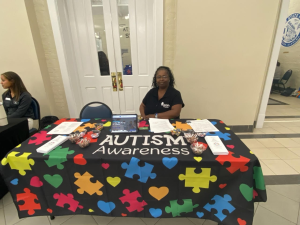Autism Awareness Month is a time to educate, uplift, and support the autistic community. Every April, individuals, families, educators, and advocates come together to spread awareness, promote acceptance, and encourage inclusivity. From the symbolism of puzzle pieces and blue-colored awareness campaigns to the increasing diagnosis rates, Autism Awareness Month is more than just recognizing autism—it’s about fostering understanding and meaningful support.
- Understanding Autism Spectrum Disorder (ASD)
Autism Spectrum Disorder (ASD) is a lifelong neurodevelopmental condition that affects communication, behavior, and social interaction. The term spectrum reflects the wide range of experiences—some individuals may have challenges with verbal communication and sensory sensitivities, while others may display exceptional skills in areas such as memory, music, or problem-solving.
Common Misconceptions and Myths About Autism
Many misunderstandings about autism persist, despite growing awareness. Some of the most common autism myths and facts include:
- Myth: Autism is only a childhood condition.
- Fact: Autism in adults is widely recognized, with many individuals receiving a late diagnosis.
- Myth: All autistic individuals struggle socially.
- Fact: While some face challenges with social interactions, others form meaningful relationships and navigate social situations successfully.
Differences in How Autism Presents in Individuals
Autism manifests uniquely in each person. Key differences include:
- Gender Differences: Autism in boys vs. girls is often distinct. Boys are diagnosed more frequently, while girls may mask traits, leading to underdiagnosis.
- Recognition of Neurodiversity: Embracing neurodiversity and autism means seeing autism as a natural variation rather than a condition needing correction.
Instead of viewing autism as a puzzle with missing pieces, we should recognize its complexity—like the way leaves fall into a unique pattern on a tree—each one different, yet equally valuable.
2. Causes and Autism Risk Factors
The causes of Autism Spectrum Disorder (ASD) are complex, and while research continues, we know that both genetics and environmental factors play a role. Autism is not caused by any one thing—it is a unique part of a person’s identity, shaped by many influences.
- Genetics: Many families with autistic individuals notice patterns, suggesting a hereditary link. However, no single gene causes autism.
- Environmental Factors: Pregnancy-related factors, such as prenatal health and exposure to certain environmental conditions, may also contribute.
- Parental Age: Research indicates that autism risk factors may include advanced parental age at conception, though many children with young parents are also diagnosed.
Co-Occurring Conditions and Their Impact
Autism is often accompanied by other conditions that can affect daily life, such as:
- ADHD, which may make focus and impulse control challenging.
- Epilepsy, a condition more common in autistic individuals.
- Gastrointestinal issues, which can cause discomfort and distress.
Recognizing these co-occurring conditions helps families find the right autism support and interventions.
Dispelling Myths with Compassion
One of the most harmful autism myths and facts is the false link between vaccines and autism. Despite extensive research proving otherwise, misinformation continues to cause fear. It is understandable that parents want to make informed decisions, which is why providing factual, science-based education is so important. Every autistic individual deserves acceptance, support, and a community that embraces them fully.
3. Early Signs and Diagnosis
Identifying Autism Spectrum Disorder (ASD) early can make a significant difference in accessing the right support. Parents and caregivers often notice differences in communication, social interaction, and behavior in early childhood. Some of the most common early signs include:
- Limited eye contact or a lack of response to their name.
- Delayed speech and language development, with some children not speaking by expected milestones.
- Repetitive movements, such as hand-flapping or rocking.
- Intense focus on specific interests, sometimes to the exclusion of other activities.
While many children display these traits, a professional evaluation is crucial to confirm a diagnosis.
Screening and Diagnosis Process
Early identification of autism is possible through standardized screening tools like:
- M-CHAT (Modified Checklist for Autism in Toddlers) – A widely used questionnaire for toddlers.
- ADOS-2 (Autism Diagnostic Observation Schedule-Second Edition) – A structured assessment used by professionals for diagnosis.
For some, autism in adults remains undiagnosed until later in life. Increased awareness highlights the importance of diagnostic tools that recognize autism at all ages.
The Importance of Early Intervention
Early diagnosis allows for timely autism support, helping children develop communication, social, and adaptive skills. While early intervention is ideal, every individual, regardless of age, deserves the opportunity to receive support, education, and acceptance during Autism Awareness Month and beyond.
4. Autism in Different Populations
For years, research has shown that boys are diagnosed with Autism Spectrum Disorder (ASD) at a significantly higher rate than girls. However, this does not mean that autism is less common in girls. Instead, many girls exhibit traits that go unnoticed due to differences in how autism presents. Key reasons for underdiagnosis include:
- Masking behaviors – Girls often adapt to social expectations, mimicking peers to blend in.
- Less noticeable traits – Autistic girls may show deep but quiet interests rather than obvious repetitive behaviors.
- Bias in diagnostic tools – Many assessments are based on how autism in boys vs. girls typically presents, leading to missed diagnoses in females.
Autism in Adults: Late Diagnosis and Challenges
Many individuals remain undiagnosed until adulthood, often struggling with social interactions, employment, and relationships. Autism in adults is increasingly recognized, but late diagnosis can mean years without necessary autism support. Workplace challenges, sensory sensitivities, and misunderstandings about autistic traits can make daily life difficult without accommodations.
Cultural Perspectives and Awareness Efforts
Cultural attitudes toward autism vary worldwide. In some regions, stigma prevents families from seeking a diagnosis, while in others, awareness campaigns promote Autism Acceptance vs. Awareness. Shifting the focus from just raising awareness to fostering true inclusion is essential during Autism Awareness Month and beyond.
5. Challenges Faced by Autistic Individuals
Autistic individuals experience the world differently, and for many, social interactions and sensory input can be overwhelming. These challenges vary from person to person but may include:
- Difficulty understanding social cues, such as facial expressions or tone of voice.
- Struggles in conversations, including knowing when to speak or how to respond in social settings.
- Sensory overload from loud noises, bright lights, or crowded spaces, which can cause distress.
These experiences are often misunderstood, reinforcing autism myths and facts that misrepresent autistic individuals. Raising awareness during Autism Awareness Month can help dispel these misconceptions.
Emotional Regulation and Mental Health Considerations
Autistic individuals may experience heightened emotions and challenges with self-regulation. Common difficulties include:
- Anxiety and stress, especially in unpredictable situations.
- Meltdowns or shutdowns, often triggered by sensory overload.
- Struggles with change, as routine provides comfort and stability.
Understanding neurodiversity and autism fosters acceptance and encourages mental health support tailored to autistic individuals.
Workplace Challenges and Accommodations
For many, autism in adults means navigating employment without proper accommodations. Challenges in the workplace may include:
- Difficulty with unstructured tasks or social expectations.
- Sensory sensitivities, such as office noise or bright lighting.
- Limited employment opportunities due to a lack of understanding from employers.
Promoting autism support in workplaces through inclusive hiring practices and accommodations ensures autistic individuals can thrive. Recognizing these challenges leads to better policies and greater acceptance beyond World Autism Awareness Month
6. Autism and Education
Education plays a vital role in supporting autistic individuals by providing tailored learning environments and accommodations. Individualized Education Programs (IEPs) and 504 Plans are essential tools that ensure students receive the necessary support.
- IEPs provide specialized instruction, therapy, and learning modifications based on a student’s unique needs.
- 504 Plans offer accommodations such as extended test time, quiet workspaces, or assistive technology to support learning.
Understanding these options allows parents and educators to make informed decisions about special education for autism and the best learning environments for each child.
Mainstream vs. Special Education: Finding the Right Fit
Choosing between mainstream vs. special education depends on individual learning styles and needs. While some autistic students thrive in traditional classrooms with support, others benefit from smaller class sizes and specialized teaching methods.
Promoting autism support in schools ensures that all students receive the right educational approach to help them succeed.
The Impact of Assistive Technology in Learning
Innovative tools can enhance educational experiences for autistic individuals. Some effective assistive technologies include:
- Speech-to-text tools for students with communication challenges.
- Visual schedules to help with transitions and routines.
- Noise-canceling headphones to reduce sensory overload.
Inclusive classrooms embracing neurodiversity and autism empower all learners, reinforcing the message of Autism Awareness Month.
7. Therapies and Interventions
Various therapies help autistic individuals develop essential skills and navigate daily life. Some of the most effective autism support strategies include:
- Applied Behavior Analysis (ABA): Focuses on behavior modification and skill-building. For those interested in making a meaningful difference, pursuing an ABA therapy career in Decatur, AL offers the opportunity to work directly with children and adults, delivering structured interventions and supporting families in both educational and home settings.
- Speech Therapy: Helps improve communication and language development.
- Occupational Therapy: Enhances motor skills, sensory processing, and daily living activities.
These therapies are widely used in both educational and home settings to support autism in adults and children.
Alternative Therapies for Emotional Expression
In addition to structured interventions, creative therapies, when paired with ABA Therapy, provide emotional and sensory benefits:
- Music Therapy: Helps with emotional regulation and communication.
- Equine Therapy: Encourages social interaction and confidence-building.
- Art Therapy: Provides a non-verbal outlet for self-expression.
- T-Ball: Promotes teamwork, coordination, and motor skill development.
Recognizing neurodiversity and autism means exploring diverse approaches to meet individual needs.
Medication for Co-Occurring Conditions
Many autistic individuals experience autism risk factors such as anxiety, ADHD, or sleep disturbances. Medication can sometimes help manage these challenges, but it should always be part of a comprehensive support plan.
During Autism Awareness Month, the focus should be on empowering individuals by building on their strengths rather than solely addressing challenges.
8. Daily Life with Autism
Raising an autistic child requires patience, advocacy, and access to the right autism support systems. Parents play a crucial role in ensuring their child receives therapies, educational accommodations, and opportunities for social development. Providing a structured routine and embracing neurodiversity and autism can create a more supportive environment.
Independent Living and Career Support
For many, autism in adults presents challenges in employment and independent living due to societal misunderstandings. However, with workplace accommodations such as flexible schedules and sensory-friendly environments, autistic individuals can thrive. Skills like budgeting, transportation planning, and job coaching help promote independence.
Creating Autism-Friendly Spaces
Inclusive communities make daily life easier for autistic individuals. Key efforts include:
- Sensory-friendly hours in public places.
- Inclusive hiring practices to support diverse talent.
- Autism-friendly travel accommodations for a smoother experience.
During Autism Awareness Month, advocating for these changes ensures a more accessible and accepting world for all.
9. Celebrating Neurodiversity and Autism
The focus of Autism Awareness Month is evolving from simply raising awareness to true inclusion. Autism Acceptance vs. Awareness emphasizes that autism is not something to be “fixed” but a unique way of experiencing the world. Recognizing neurodiversity and autism helps shift perspectives toward valuing differences rather than stigmatizing them.
Recognizing Strengths and Contributions
Autistic individuals bring immense talent and innovation across various fields, including:
- Science and technology, where analytical thinking and attention to detail drive advancements.
- Art and creativity, with many autistic individuals excelling in visual and performing arts.
- Advocacy and leadership, where voices from the autistic community promote meaningful change.
Honoring Prominent Autistic Figures
From renowned scientists to groundbreaking artists, autistic individuals have made lasting contributions. By celebrating these achievements during Autism Awareness Month, society fosters a more inclusive world—one that recognizes strengths, not just challenges.
10. Autism Advocacy & Awareness
Advocacy during Autism Awareness Month is key to fostering inclusivity in businesses, schools, and public spaces. Steps toward a more autism-friendly society include:
- Training programs on autism support and inclusion for employees and educators.
- Sensory-friendly spaces in workplaces, stores, and recreational areas.
- Accessibility policies ensure equal opportunities for autistic individuals.
When businesses and schools embrace neurodiversity and autism, they create environments where everyone can thrive.
Resources for Parents and Caregivers
Families play a vital role in supporting autistic individuals. Resources such as therapy programs, financial assistance, and community events strengthen the support network and promote autism in education and daily life.
Recognizing World Autism Awareness Day
April 2 marks World Autism Awareness Day, highlighting the importance of acceptance and advocacy. Through events, social campaigns, and ongoing initiatives, Autism Awareness Month encourages greater understanding and meaningful change for autistic individuals worldwide.
Taking Action Beyond Awareness
Autism Awareness Month is more than just recognition—it’s a call to action. Through support, acceptance, and meaningful advocacy, autistic individuals can thrive in every aspect of life.
For more information or support, contact us today.





